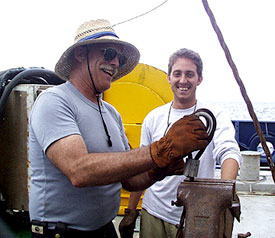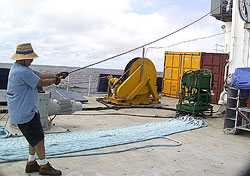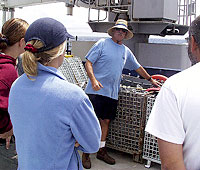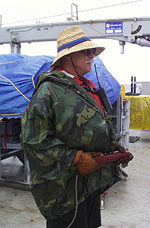|
|
Interviews: Resident Marine Technician Gene Pillard What are your main responsibilities on board? Gene: I’m the Resident Marine Technician. I was hired by Scripps in 1981. My function is the main liaison between the ship’s crew and equipment and the scientific party. My job is to make sure they reach 100% of their scientific goals. Along with that I’m the primary deck safety officer. I’m in charge of all equipment deployments and recovery, as well as setting up the science labs with the proper equipment so that scientists can go home happy with all their science.
How did you get involved in this type of work? Gene: Starting in 1976, I worked for three years as a marine technician for a biological firm that was doing a near-shore environmental impact study on a nuclear power plant in southern California. I also spent two years as a private consultant procuring small shrimplike crustaceans called mysids for bioassay. The Army Corps of Engineers had determined that studies on this and other indicator species could show how toxic materials and minerals affected the overall ecosystem and how much it would need to be diluted when introduced in the ocean. Question: What did you do in school? Gene: I went to UCSB (University of California at Santa Barbara) and graduated in biological sciences in 1973. I went to college thinking that I wanted to be a dentist. During my junior year I applied and got accepted to a couple of dental schools. One of my roommates had gone on to the UCLA dental school and I went down to visit. I spent a couple of days attending lectures and labs and meeting people, but for some reason it was a very bad experience. I learned dentistry was something I didn’t really want to do. Question: What did you do then? Gene: During my college career I worked as a beach lifeguard and as a favor for the district superintendent I took the two civil service position tests for the state department of parks and recreation: one for permanent lifeguard and one for lifeguard superintendent. Just out of the blue, I got hired as a permanent guard. It wasn’t something I wanted to do but it gave me an opportunity to save money for a surf trip. But before I got to go on my surf trip to Costa Rica, I got hired as the lifeguard supervisor on the San Diego Coast beaches. I did that for a couple of years and at that time I also made some investments in some clothing and sandal lines and I started to do wholesaling and importing clothes from Australia and Bali. Thirty years later I finally made that surf trip during my last trip to Costa Rica.
Where have you been surfing? Gene: I started surfing when I was 14 in California. Scripps has given me the opportunity to surf places many people never have. I’ve surfed Easter Island, Tahiti, Peru, Panama, Chile, Australia and New Zealand. I’ve even surfed the Galapagos before. I ride a 9’1” Longboard and a 7’8” Thruster. I have a 9’3” board on the Melville and several boards at home in Cardiff, Calif., north of San Diego. Question: What kind experiences have you seen working for Scripps? Gene: Well there are two extremes. The minimal trip from my perspective would be a multibeam mapping survey where once you get all the scientists buttoned in all they do is mow the lawn back and forth with the ship to map the bottom. From 23 degrees North to 23 degrees South latitude is the preferred place to do oceanography - from the Tropic of Cancer to the Tropic of Capricorn. That’s the tropics. Every night is a beautiful sunset and I can’t believe they pay me to do this job. The other extreme is in the southern ocean anywhere between 45 degrees South to 60 degrees South latitude - the roaring 40s. It’s one of the worse places to be with a ship, because you look at a map and there’s a huge fetch, that’s the distance of a body of water that wind can blow across. The longer the fetch the bigger and uglier the waves become. A good day in the southern ocean is 10 to 15 foot swells and only 20 to 30 knot winds. But weather can change rapidly and in an hour we may have to recover a dredge with 40 to 45 knot winds with horizontal sleet and the ship rolling 20 degrees. You just can’t protect enough of your body to keep it all warm. You’re wet, you’re cold and because the ship operates 24 hours a day it’s in the wee hours of the morning when you think, wow, they just don’t pay me enough to do this job.
Where is your family? Gene: I have a 13-year-old son named Jimmy who lives with his mom in Eugene, Or. I also have a 5-year-old son, Alexander, who lives with his mom, Carina Lange, and me in California. But we’re currently in the process of moving to Chile. Carina is a researcher at Scripps and has just been offered a professor position at the University of Conception. I’ll be getting off the ship at Easter Island in December and meeting them there. So I guess Ill soon have an 8,000-mile commute! |
||||||||||
Mailing List | Feedback | Glossary | For Teachers | About Us | Contact
© 2010 Dive and Discover™. Dive and Discover™ is a registered trademark of
Woods
Hole Oceanographic Institution

 Gene is always around helping make things easier for the scientists. Here he and Todd Ericksen “terminate a wire.” This involves making a loop on the end of the steel wire so that it can be easily attached to the dredge or deep sea camera.
Gene is always around helping make things easier for the scientists. Here he and Todd Ericksen “terminate a wire.” This involves making a loop on the end of the steel wire so that it can be easily attached to the dredge or deep sea camera.


